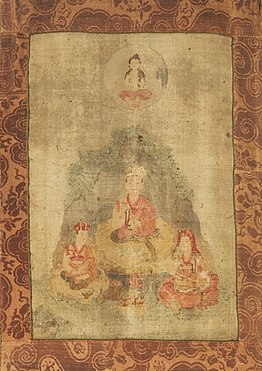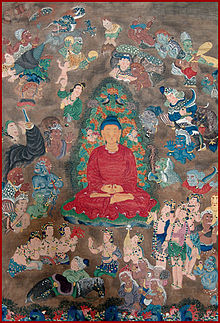This article needs additional citations for verification. (November 2010) |
Chöying Dorje (1604–1674) was the tenth Karmapa or head of the Kagyu school of Tibetan Buddhism.


Chöying Dorje was born in the kingdom of Golok, Amdo. At the age of eight, he was recognized by Shamar Mipam Chökyi Wangchuk, the sixth Shamarpa and received the complete Kagyu transmissions.[1]
During his life, Tibet faced inner instability as a pro-Kagyu king suppressed - against the will of the Karmapa - the Gelug school and forbade the search for the reincarnation of the Dalai Lama. The regent of the Gelug asked Güshi Khan, the warrior king of the Khoshut Mongols, for help.
The Mongolian army attacked Shigatse and forced many monasteries to convert to the Gelug school.[2][3] The civil war became such that Chöying Dorje had to flee Tibet and he appointed Goshir Gyaltsab as the temporary regent. The Kagyu school was almost completely annihilated in Tsang province, however, it remained in the provinces of Amdo and Kham.

Exile
editDuring his exile (1648 to 1672), Chöying Dorje travelled extensively through Bhutan, Amdo and Kham in East Tibet, Burma and Nepal, founding monasteries along his route.[4] Traveling through dangerous lands he often concealed his identity, wearing common clothes, and was at times robbed and reduced too begging for food in a region he didn't speak the dialect. He wrote books on various subjects, composed songs and made an enormous number of paintings and sculptures. Also, while in exile he returned his monks vows and had a family.[5]
Family and children
editIt's likely when Karmapa was in the far southeast of Tibet for a period of twelve years, is when he took a consort. He fathered several sons and daughters. One of his sons, Norbu Zangpo, who was recognized as the Sixth Tsurpu Gyeltsab (c.1659-1698). Karmapa enthroned his 3 year old son Norbu Zangpo in a temple he helped build in Gyeltang with his bare hands. In 1667 the Karmapa brought him to Riknga Temple and performed novice ordination. In 1672 the Karmapa returned to central Tibet with a large entourage that included his wife, sons, and daughters. Most likely the main reason for returning was to arrange the installment of his son Norbu Zangpo at Tsurpu.[6]
Return to Central Tibet
editAfter twenty-four years of exile, the Kagyu school was no longer the dominant school of Tibetan Buddhism. In 1674 the 5th Dalai Lama met with Chöying Dorje at the Potala Palace, and the reconciliation was welcomed by all after the many conflicts and difficulties. However, Chöying Dorje was not allowed by the Dalai Lama to return to his monastery at Tsurpu.[7]
Art
editWithin the Tibetan artistic heritage, Chöying Dorje is perhaps the most exceptional artist of all times. The various biographies agree that the 10th Karmapa was a talented painter and sculptor already at a young age. It is also repeatedly stated that he was from a young age especially fond of Indian statues from Kashmir. This explains why many of the statues made by the Tenth Karmapa – regardless whether cast in metal or carved in ivory, wood, or conch shell, etc. – are stylistically very close to brass statues from Kashmir and Swat.
However, Chöying Dorje was not simply copying ancient Indian and Tibetan works. Just inspired, he rather created his own work of art – albeit using ancient stylistic elements. As mentioned in his biographies, he had ample opportunity to study early statues during his recurring visits to the Jokhang temple in Lhasa. His activities as a painter were evidently influenced by the Chinese tradition, which also explains why Chöying Dorje painted many works on silk. Chinese influence in the works of Chöying Dorje has its origin in arhat paintings that he had seen in Tibet and copied several times. The Tenth Karmapa also encountered other Chinese silk paintings during his exile in Lijiang, where he stayed for several years at the court of the local ruler. Chöying Dorje also created paintings influenced by Kashmir and Western Tibetan styles.[8][9]
References
edit- ^ "The 10th Karmapa".
- ^ Laird, Thomas. (2006). The Story of Tibet: Conversations with the Dalai Lama, p. 165. Grove Press, New York. ISBN 978-0-8021-1827-1.
- ^ Richardson, Hugh E. (1984). Tibet and its History. Second Edition, Revised and Updated, p. 42. Shambhala. Boston & London. ISBN 0-87773-376-7.(pbk)
- ^ "The 10th Karmapa".
- ^ "The Tenth Karmapa, Choying Dorje".
- ^ "The Tenth Karmapa, Choying Dorje".
- ^ Karmay, Samten C. (2005). "The Great Fifth", p. 2. Downloaded as a pdf file on 16 December 2007 from: [1] Archived 15 September 2013 at the Wayback Machine
- ^ von Schroeder, Ulrich. Buddhist Sculptures in Tibet. Vol. One: India & Nepal; Vol. Two: Tibet & China; pp. 96, 530, 702, 706, 744 nn. 619–620; 745, 747, 752, 754, 756, 762, 764, 796–819, 997, 1126, 1223, 1230; Figs. XII–18–25; Pls. 16D–E (?), 191–194, 340B (?). (Hong Kong: Visual Dharma Publications, Ltd, 2001.) ISBN 962-7049-07-7; ISBN 978-962-7049-07-4.
- ^ von Schroeder, Ulrich. Buddhist Sculptures of the Alain Bordier Foundation. pp. 50–51, pl. 22A. (Hong Kong: Visual Dharma Publications, Ltd., for the Alain Bordier Foundation, 2010) ISBN 962-7049-14-X; ISBN 978-962-7049-14-2
Further reading
edit- Thinley, Karma (2008). The Black Hat Eccentric: Artistic Visions of the Tenth Karmapa. USA: Prajna Press. p. 150. ISBN 978-1-57062-644-9.
- Debreczeny, Karl (2012). The History of Sixteen Karmapas of Tibet. New York: Rubin Museum of Art. ISBN 978-0977213108.
- Rinpoche, Sharmar (2012). A Golden Swan in Turbulent Waters: The Life and Times of the Tenth Karmapa Choying Dorje. USA: Bird of Paradise Press. ISBN 978-0988176201.